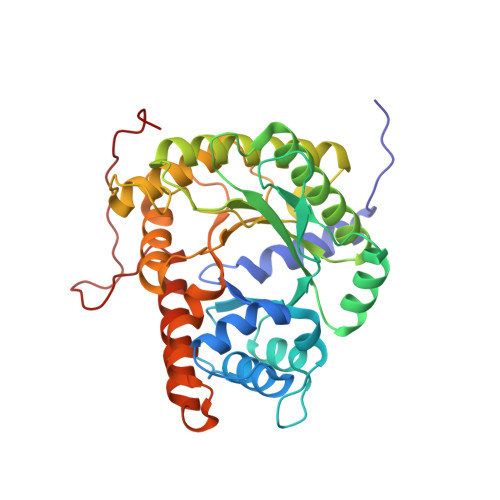High Resolution Reaction Intermediates of Rabbit Muscle Fructose-1,6-bisphosphate Aldolase: substrate cleavage and induced fit.
St-Jean, M., Lafrance-Vanasse, J., Liotard, B., Sygusch, J.(2005) J Biol Chem 280: 27262-27270
- PubMed: 15870069
- DOI: https://doi.org/10.1074/jbc.M502413200
- Primary Citation of Related Structures:
1ZAH, 1ZAI, 1ZAJ, 1ZAL - PubMed Abstract:
Crystal structures were determined to 1.8 A resolution of the glycolytic enzyme fructose-1,6-bis(phosphate) aldolase trapped in complex with its substrate and a competitive inhibitor, mannitol-1,6-bis(phosphate). The enzyme substrate complex corresponded to the postulated Schiff base intermediate and has reaction geometry consistent with incipient C3-C4 bond cleavage catalyzed Glu-187, which is adjacent by to the Schiff base forming Lys-229. Atom arrangement about the cleaved bond in the reaction intermediate mimics a pericyclic transition state occurring in nonenzymatic aldol condensations. Lys-146 hydrogen-bonds the substrate C4 hydroxyl and assists substrate cleavage by stabilizing the developing negative charge on the C4 hydroxyl during proton abstraction. Mannitol-1,6-bis(phosphate) forms a noncovalent complex in the active site whose binding geometry mimics the covalent carbinolamine precursor. Glu-187 hydrogen-bonds the C2 hydroxyl of the inhibitor in the enzyme complex, substantiating a proton transfer role by Glu-187 in catalyzing the conversion of the carbinolamine intermediate to Schiff base. Modeling of the acyclic substrate configuration into the active site shows Glu-187, in acid form, hydrogen-bonding both substrate C2 carbonyl and C4 hydroxyl, thereby aligning the substrate ketose for nucleophilic attack by Lys-229. The multifunctional role of Glu-187 epitomizes a canonical mechanistic feature conserved in Schiff base-forming aldolases catalyzing carbohydrate metabolism. Trapping of tagatose-1,6-bis(phosphate), a diastereoisomer of fructose 1,6-bis(phosphate), displayed stereospecific discrimination and reduced ketohexose binding specificity. Each ligand induces homologous conformational changes in two adjacent alpha-helical regions that promote phosphate binding in the active site.
Organizational Affiliation:
Department of Biochemistry, Université de Montréal, Montréal, Québec H3C 3J7, Canada.















